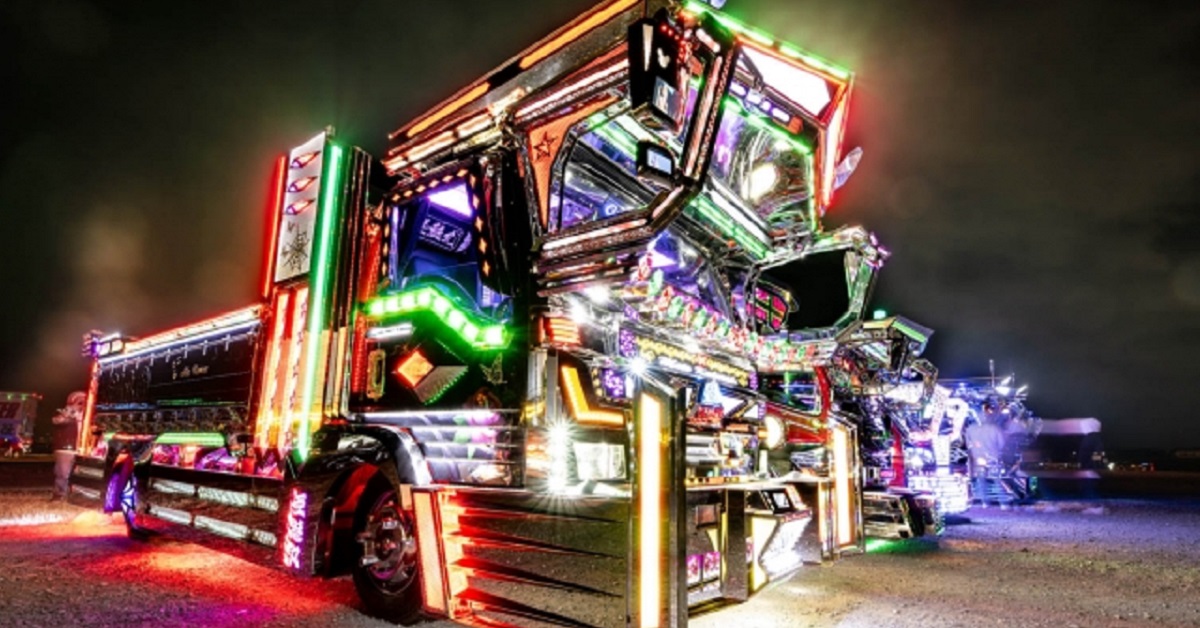Dekotora (Decoration Truck) represents one of Japan’s most distinctive cultural symbols.
Adorned with vibrant lights and bold artwork, these trucks are more than just vehicles—they are a living form of art that embodies pride in labor and the pursuit of beauty.
What Is a Dekotora (Decoration Truck)
Dekotora (Decoration Truck) is short for “Decoration Truck.” It originated in Japan during the 1970s, when long-haul truck drivers began decorating their vehicles with chrome, neon lights, and airbrushed artwork. At night, these trucks shine like jewels on the highway—true works of craftsmanship on wheels.
| Element | Description |
|---|---|
| Origin | 1970s Japan, created by long-distance truck drivers |
| Meaning | Short for “Decoration Truck,” symbolizing pride and individuality |
| Features | Chrome plating, lights, airbrush art, sculptures |
| English Term | Japanese Art Truck / Dekotora |
| Recognition | Celebrated worldwide as “Moving Art” |
Dekotora is not just a hobby, but a blend of self-expression and respect for one’s work vehicle. Owners infuse their beliefs, passions, and creativity into their trucks. This culture is deeply connected to Japan’s craftsmanship ethos and its devotion to beauty in detail.
History and Evolution of Dekotora
The origins of Dekotora (Decoration Truck) trace back to Japan’s period of rapid economic growth in the late 1960s and early 1970s. During that time, truck drivers played a vital role in nationwide logistics. Working under demanding conditions, they began decorating their vehicles to express pride and solidarity.
In 1975, the film series “Torakku Yaro” (Truck Guys) became a nationwide hit, propelling Dekotora culture into the spotlight. The main character’s truck, Ichibanboshi-go (“First Star”), became a cultural icon, admired for its spectacular lights and bold designs.
| Region | Characteristic | Design Style |
|---|---|---|
| Tohoku | Heavy use of lights and chrome | Grand and luminous |
| Kanto | Mix of traditional and modern | Balanced and elegant |
| Kansai | Emphasis on engraving and painting | Precise, artisanal quality |
Each region’s style reflects its local culture and aesthetic values. Dekotora evolved as both an art form and a symbol of community among Japan’s working-class heroes.
Design and Aesthetic Philosophy
The artistry of Dekotora (Decoration Truck) is not about being flashy for its own sake. Behind the vibrant exterior lies a disciplined sense of beauty and harmony. Popular motifs such as dragons, cherry blossoms, Mount Fuji, cranes, and ocean waves represent traditional Japanese ideals of strength, purity, and progress.
| Motif | Symbolism | Usage Example |
|---|---|---|
| Dragon | Power and protection | Golden dragon along the truck side |
| Cherry blossom | Fleeting beauty and Japanese identity | Pink lighting and paintwork |
| Mount Fuji | National pride | Painted on the rear or cabin |
| Crane | Longevity and luck | Winged cranes in motion |
| Wave | Energy and progress | Chrome patterns symbolizing movement |
The interior of a Dekotora is equally elaborate. Gold-leaf panels, embroidered seats, and shining meters create an immersive artistic space for the driver. Every detail expresses care and pride. A Dekotora is both a workplace and a mirror of its owner’s soul.
Dekotora and Japanese Society
Dekotora culture represents the pride of Japan’s working class. For long-haul drivers, customizing their truck is not merely decoration—it is a way to honor their profession and strengthen bonds with fellow drivers.
However, as traffic and safety regulations tightened, some traditional designs became impractical. This led to the rise of Neo-Dekotora, a modern evolution that uses LED lighting, lightweight materials, and eco-friendly components. These trucks emphasize design harmony, safety, and sustainability.
Many Dekotora owners also participate in charity and community events. They display their trucks at festivals and donate proceeds to disaster relief or local causes. Thus, Dekotora serves not only as personal expression but as a bridge connecting art, work, and community.
How the World Sees Dekotora (Decoration Trucks)
To foreigners, Dekotora appears strikingly unique. While Western trucking culture prioritizes functionality, Japan’s Dekotora transforms trucks into canvases of creativity. It is often described as “a fusion of art and labor.”
| Country/Region | Perception | Cultural Impact |
|---|---|---|
| United States | Recognized as “Japanese Art Truck” | Featured in documentaries and exhibitions |
| France | Viewed as urban Japanese art | Displayed at photo and art fairs |
| Taiwan & Korea | Influential and relatable | Inspired decorated bikes and mini-trucks |
| United Kingdom | Appreciated as subculture | Growing interest among youth |
Foreign audiences see in Dekotora the Japanese spirit of diligence, pride, and artistry. It is not just about trucks—it’s about transforming work into beauty, and function into culture.
Modern Dekotora and the Road Ahead
Today, Dekotora (Decoration Truck) continues to evolve. Environmental awareness has led to the rise of eco-Dekotora, featuring solar panels, LED systems, and lighter materials. Younger enthusiasts now use social media to showcase their designs, spreading the culture globally.
Some creators are experimenting with AI-driven design and digital projection lighting, adding a futuristic dimension to the art. Dekotora has become Japan’s new cultural export, bridging traditional craftsmanship and digital innovation.
Conclusion
Dekotora (Decoration Truck) is more than a vehicle—it is a living expression of Japanese spirit, craftsmanship, and aesthetics. It embodies the pride of workers, the unity of communities, and the artistic soul of Japan.
As it continues to evolve, the Dekotora culture will balance tradition with innovation, merging environmental awareness with artistic brilliance. Wherever it travels, a Dekotora carries more than goods—it carries the heart of Japan, glowing brightly on the road.






